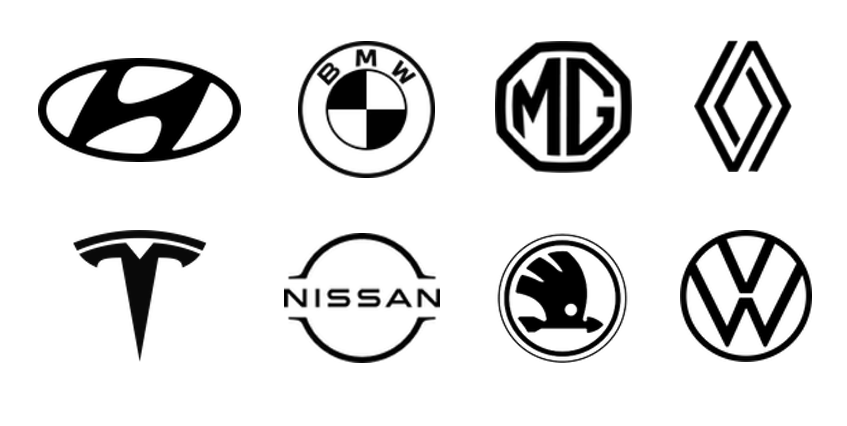Charge electric vehicles
All modern electric vehicles have in common that they use one of the charging standards mentioned above (Type 1, Type 2, CHAdeMO, Combo 2 / CCS).
It must therefore first be distinguished that charges with type 1 (single-phase) or type 2 (single-phase, multi-phase) are always AC charges (except for proprietary systems such as Tesla Supercharger).
With the exception of the Renault ZOE, a vehicle that also uses drive components as a charger for charging, all vehicles have in common that a dedicated internal charger is installed, whose task is to convert the AC power supplied from the power grid into DC ( DC) for the battery to convert – this is because the battery can only store direct current (DC).
As a result, the vehicles are limited in their charging capacity by the components required for AC charging.
Depending on the vehicle model and charger type, charging capacities between 3.7 kW (16A, single-phase) and 43 kW (63A, three-phase) are achieved.
Last but not least, these chargers require space and there is a loss of conversion (usually in the single-digit percentage range). This in turn also means waste heat, which is why the placement and the thermal load in the vehicle are also of importance due to the design.
Almost all modern electric vehicles, with the exception of the Renault ZOE, are also able to charge direct current (DC).
The charging standards CCS (Combo 2) or CHAdeMO are used for this.
By bypassing the charger in the vehicle and supplying the charging current directly to the battery, higher charging capacities can usually be achieved (e.g. 50 kW DC).
When charging with direct current (DC), the battery specifies the voltage and current required. It is basically the “boss” and tells the column how to load (master / slave).
The temperature of the cells in the battery also has a direct impact on the charging performance.
For example, if the cell temperature is particularly high or the cell temperature is particularly low, the charging power may be throttled (to protect the battery).
Most manufacturers therefore use a so-called thermal management system (TMS) to regulate the cell temperature in summer and winter.
For example, vehicles such as the Tesla Model S or X have a liquid thermal management system that can supply or remove heat particularly well. Other vehicles such as Hyundai IONIQ Elektro or Renault ZOE use an air thermal management system that can regulate the temperature by supplying fresh air, air from the interior or by using the air conditioning system – and also supports the cell temperature in winter with its own PTC heating elements increased (eg during the pre-conditioning of the vehicle).
Vehicles such as the VW eGolf or the Nissan Leaf (24-40 kWh) use a passive system (airstream, regulation of the charging current) in order not to exceed the cell temperatures specified by the manufacturer.
The higher the charging capacity to be achieved, the more factors such as battery size, cell chemistry, cell temperature and thermal management have an impact on the overall charge.
In winter, it is therefore advisable to carry out a quick charge overnight before parking the vehicle, or to carry out a slower charge during the night (e.g. at home) – in summer, however, it may be that high cell temperatures reduce the quick charge performance.
These specifics differ from vehicle to vehicle and it depends above all on the individual use of the vehicle (range requirements, charging behavior, etc.).

Typ 1 (AC)

Typ 2 (AC)

CCS-Combo 2 (DC)

CHAdeMO (DC)
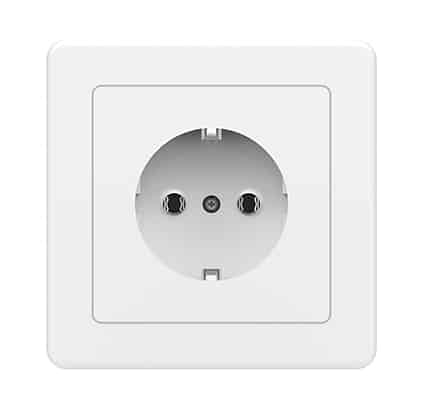
Safety plug (household socket)
E-vehicles can also be charged via the standard household socket, where we use devices of our daily needs (laptop, television, toaster …). Manufacturers usually deliver their vehicles as “emergency charging cables”, small and mobile chargers.
Charging powers of up to 3 kW (13A 230V) are the rule here – due to the household socket not being designed for such a high continuous load (i.e. charging at full power for tens of hours, as would be possible with larger battery capacities, for example) Household socket is not the optimal choice for permanent use as a power source for modern e-vehicles.
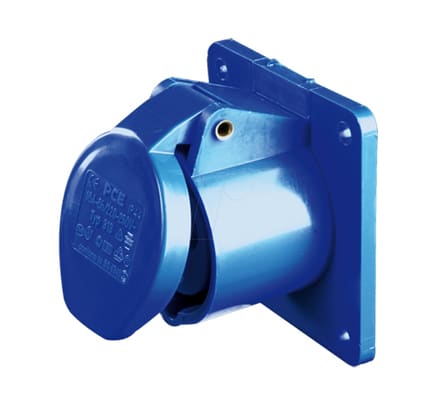
CEE socket blue
The blue CEE socket (3-pin) – offers a single-phase charge from 3.7 kW (16A 230V) to 7.4 kW * (32A 230V).
Since most mobile charging stations are only able to use this socket via an adapter, it is of little importance for charging electric vehicles. However, the blue CEE socket is more suitable for permanent use as a primary power source, than the household socket.
It is therefore recommended to replace the existing household socket as a power source for charging an electric vehicle.
* Observe unbalanced load regulation
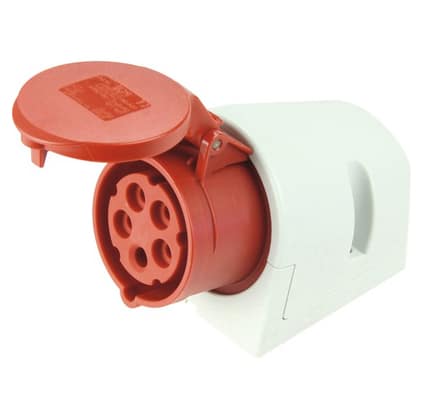
CEE socket red (three-phase current)
The 5-pin three-phase socket (CEE red 5-pin), also known as a high-voltage or power socket, offers a solid basis, especially for mobile, intelligent charging cables (mobile charging stations such as NRGkick).
With charging powers of up to 22 kW (CEE red 5-pin 32A 400V) or 11 kW (CEE red 5-pin 16A 400V), modern electric vehicles can be charged particularly quickly and easily.
The big advantage is usually the lack of additional installation work, since many houses are already equipped with three-phase sockets.
Nevertheless, it is always a good idea to consult a specialist electrician to check the entire installation and to ensure that it is safe before starting up a mobile charging station.
Alternating current
Alternating current (AC) is the electricity that we use every day in the household.
It is the type of electricity that comes from our sockets.
The electric motors in the electric cars use alternating current (three-phase current) to function.
Every electric car uses alternating current (regardless of whether single-phase, two-phase or three-phase) to be charged, whereby only the charging process is carried out with alternating current (or three-phase current).
Direct current always comes into the battery. To do this, the car converts the alternating current that is charged and then stores it in the battery.
Direct current
Direct current (DC) is the current that is stored in all batteries.
Direct current is also stored in the drive batteries (cells) of the electric vehicles.
This is converted back into alternating current for the drive (motor) for the operation of the electric vehicle.
Charging with direct current (DC) has the advantage that the current is fed directly into the battery.
This means that no (expensive) charger in the car is required to convert the AC power from the mains into DC power for the battery.
However, the process already takes place in the charging station, which means that it becomes expensive due to the components required for this.
As a rule, charging with direct current (DC) is faster than charging with alternating current (AC).
Due to the higher cost of the charging infrastructure for charging with direct current (DC), direct current fast charging stations are less common than alternating current (AC) charging stations.
However, the majority of electric vehicles available only use direct current to carry out quick charges.
The charging capacity with which your electric vehicle charges always results from the following points:
– number of phases
– Tension
– current
With the phases, a distinction is usually made between single-phase and three-phase (three-phase) charges.
While a Schuko socket has only one phase (L1), a CEE socket (often also referred to as a power socket or three-phase socket) usually has three phases (L1, L2, L3).
Each phase supplies a specific current (ampere).
A normal household socket usually offers currents between 8A and 12A, whereby a permanent load over several hours is not provided and should therefore only be provided for the charging operation of an electric vehicle for a short time and as an “emergency charge”.
A red 5-pin CEE socket (three-phase socket / power socket) usually offers a current of 16A to 32A (5-pin, 3 phases + neutral (N) + earth (PE)), whereby there are different sizes between 16A and 25A due to the design / 32A three-phase sockets, where the supply cross-section and the connection-side fuse (FI, LS) must be dimensioned accordingly.
Now there is always a certain voltage between the phases. With us usually 230V.
Multiplying the current strength of the phase by the voltage results in the power (the charging current) with which the charge is made per phase –
it is given in watts or kiloWatt (kW).
On a Schuko socket with 10A current at 230V voltage, this would result in 2.3 kW (2300 watts) of charging current.
On a (red / blue) CEE socket with 16A current at 230V voltage, this would result in 3.7 kW (3700 watts) of charging current – per phase.
Since there are three phases in CEE red (5-pin), a total of 3 x 3.7 kW, i.e. 11 kW charging current, is available.
Therefore, always have your installation (socket, supply line, fuse) checked by a professionally suitable and licensed specialist and regularly serviced to avoid defects, cable fires or worse.
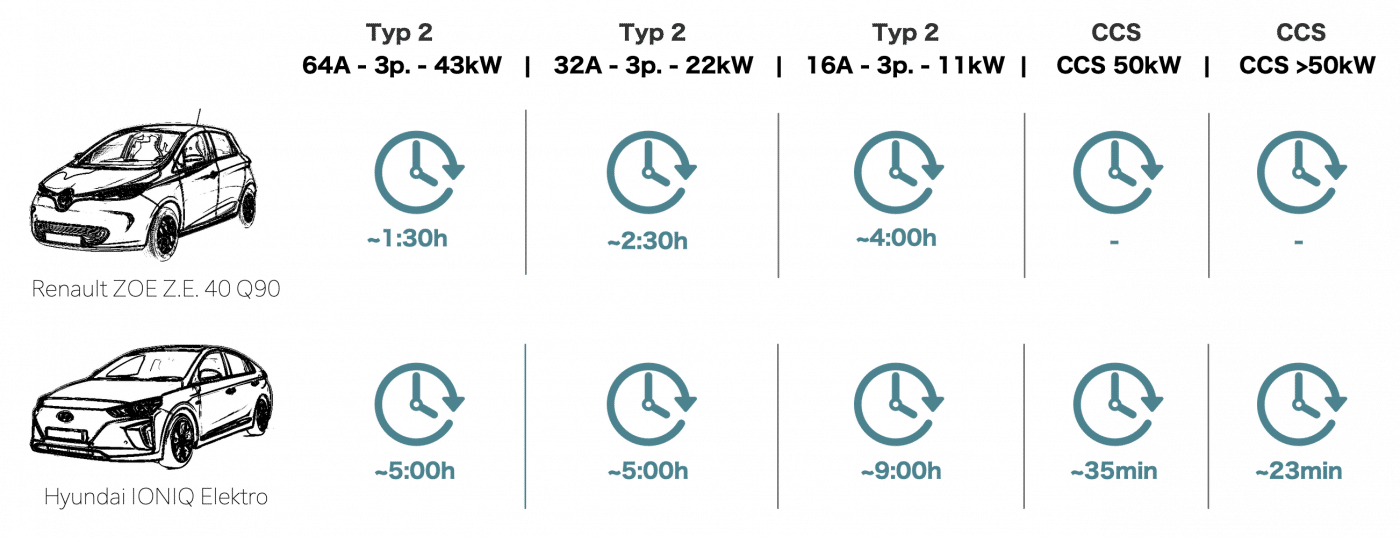
E-vehicles are equipped with modern lithium-ion drive batteries.
These are sometimes also temperature-sensitive, which is why vehicle manufacturers use the battery management system (BMS), i.e. the battery monitoring software, to design certain parameters so conservatively that charging is easy for the user under normal conditions.
Large temperature differences, for example. Heat in summer and cold in winter ensure that the cells in the battery, which is usually a massive object, assume these ambient temperatures and that these cell temperatures change during operation due to the driving and charging of the vehicle.
If the battery cells now operate in a temperature window that is less favorable for them, the vehicle’s BMS takes measures to protect the battery. These measures can, for example, bring about a reduction in the charging power, which in certain circumstances can result in longer charging times.
That is why the vehicle manufacturers use so-called thermal management systems, i.e. technical facilities, to temper the battery cells. This can be a simple ventilation or cooling via the air conditioning system (air) or a liquid thermal management system in which a special mixture can both heat and cool the cells.
This ensures that the cells are at the optimal temperature and that the user can charge without losing comfort.
Some vehicles (Nissan Leaf, VW eGolf, VW eUp) do not have “active” thermal management but only cool passively (wind).
If the cells are now “cold” in winter, the BMS may reduce the charging capacity in order not to “stress” the cells too much. Conversely, the charging power (or drive power) is reduced to protect the cell against excessive wear (aging), the so-called degradation, if the cell temperature is too high.
That is why it makes sense to charge the electric vehicle immediately after arrival (winter) when the cells are at a comfortable temperature level (the cells cool down overnight).

 Deutsch
Deutsch

